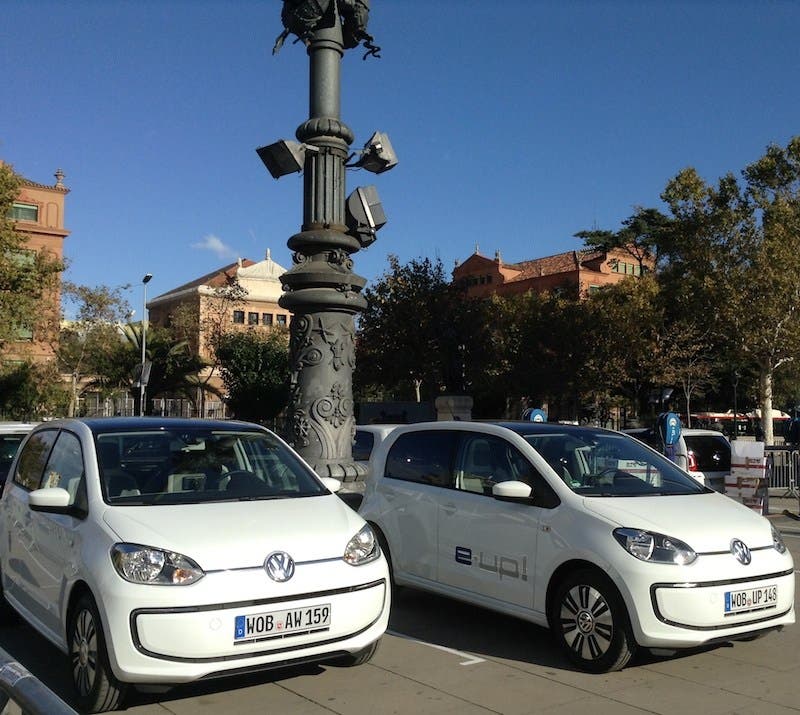
In a press release, Volkswagen Group says it is focusing its strategic alignments and launching performance programs at all brands to strengthen profitability and cash flow. CEO Oliver Blume said, “We have realigned Volkswagen Group strategically and technologically. Customer orientation, entrepreneurship, and team spirit determine our actions. Ambitious, strategic return targets with structured performance programs strengthen our financial robustness.”
That is a load of happy talk that actually says very little. But Autocar has its own take on the news and it includes a suggestion that an ID.1 vehicle — which would be the spiritual successor to the e-Up! — may be in the works and could have a base price of around €17,000.
Using a new bespoke electric platform that will underpin similar models from sibling brands Cupra and Skoda, the ID.1 will sit below the production version of the recently revealed ID.2all concept, which VW is aiming to sell for around £22,500 (€26,169). Volkswagen Group CFO Arno Antlitz recently said he believes the firm can deliver electric cars at this price point, citing the emergence of cheaper battery materials and production methods.
“For the time being, we’re quite confident that we can achieve that price point. There are a lot of innovations coming on the technical side. This car will have the first in-house battery cells from our Valencia plant. We’re just ramping up. We will have much more scale by then. [We have also seen a slight] improvement or relief on the raw material cost. Look at lithium: it came down. Nickel came down. So, from this perspective, we’re quite confident that we can achieve that €25,000 [£22,500] target and, at the same time, have a decent margin.”
Volkswagen has recently announced it has a new dry coating process for its batteries that it says will lower the price of batteries for all of its electric cars. Volkswagen Group is putting a major emphasis on developing unified battery cell technology that can be applied across all of its brands, and could potentially reduce costs by up to 50%.
Volkswagen ID.1
His comments referred specifically to the production viability of the ID.2, but could suggest the rumored ID.1 at a lower price point is feasible. Autocar says that while details of the ID.1 architecture have yet to be divulged, it will be distinct from the MEB entry platform that will be shared by the ID.2, Cupra Raval, and Skoda’s compact crossover, all of which will all be built in Spain beginning in 2025. The new platform will be developed by Volkswagen Group, with Skoda playing a key role. It will be similar in size and interior space to the VW Polo.
Volkswagen brand boss Thomas Schäfer has declined to say whether the new city car would be called ID.1 or ID Polo. Although, he has said the use of classic model names will be reserved for true successors to the original. The decision to build the new small car could depend on the final Euro 7 emissions rules. If they allow Volkswagen to continue using an internal combustion engine in the Polo, the small electric car could be put on hold.
If there is an ID.1, it will be intended mostly for urban use, meaning range will be a secondary concern. That, in turn, will allow the company to fit a smaller battery which will help make the lower price possible. Volkswagen has developed a 38 kWh LFP battery for the ID.2all, and that is likely to be the largest capacity considered for the new model. That would allow a range of around 200 would still potentially allow for a range of under 200 miles, which would be similar to the Fiat 500e.
Schäfer has hinted the new low price model could be built in markets such as India, where Volkswagen Group has production facilities and the cost of manufacturing is lower. However, it could be offered in Europe and tariff rules might make some local production possible.
Volkswagen SSP Platform Back On Track For 2026
We hear a lot about platforms for electric vehicles. Last week, Hyundai announced it is planning the successor to its E-GMP EV platform. The new Integrated Modular Platform is designed to serve as the basis for all EVs from the Hyundai Group in the future. A platform is an extension of the manufacturing philosophy pioneered by Henry Ford more than a century ago. Instead of making every car by hand, standardize the design and the parts to make it cost less.
The modern platform for electric cars seeks to standardize as many parts customers don’t see as possible — battery management and cooling systems, motors, battery packs, inverters, and so forth — so cars can be assembled quickly and profitably. The wheelbase and the width of the cars produced may change but the heart of the cars will be the same and come from a common parts bin. Lately, software has become as important as hardware, as manufacturers struggle to incorporate over-the-air updates and semi-autonomous driving systems into their cars — two innovations that Tesla pioneered a decade ago.
When Herbert Diess was running the show at Volkswagen Group, he was pushing the development of a second-generation electric car platform that would serve the needs of virtually every electric car manufactured by all the various brands within the group. Called the Scalable Systems Platform, it was supposed to avoid the costs associated with using a number of different electric car platforms. While waiting for the SSP platform, Audi is leading the way on a Premium Performance Electric platform that will be the basis of the upcoming Porsche e-Macan and Audi Q6 e-tron.
Ultimately, Volkswagen Group wants a unified electric car platform that will serve as the basis for everything from small city cars to mighty sports cars. As it is, is has the MEB platform, a planned MEB+ platform coming in 2025, an MEB Entry platform that will be used for cars like the ID.2all, perhaps yet another platform for the proposed ID.1 mentioned above, and the PPE from Porsche/Audi.
The CARIAD Dilemma
A few months back, there was an uprising at Volkswagen because the software development for the SSP platform was years behind. Porsche and Audi were screaming that their development plans were being torpedoed by the delay. As a result, the entire management team at CARIAD, the subsidiary responsible for software development, was tossed overboard and there were dire warnings that SSP would be delayed until 2028 — at the earliest.
And yet, last week, at the capital markets day event, current Volkswagen Group CEO Oliver Blume told investors the SSP project is back on track and will be ready by 2026. That new management team at CARIAD must be composed of superheroes! Blume told those in attendance, “The SSP architecture will balance the need for scale and standardization with differentiation and speed,” according to Autocar. Originally, SSP was supposed to be capable of handling up to 1100 horsepower, but Blume now says the platform will be able to support cars with up to 1700 horsepower. That hints at the possibility of some pretty amazing future electrics coming from Porsche, Bentley, or Lamborghini.
Blume added that “most” vehicles on the SSP platform will achieve profit margin parity with conventional cars. That parity is only possible with some of the models based on the MEB platform. “Architectures cover up to 75% of all material costs for BEV, compared to up to 10% for ICE,” Blume said. “Therefore, architectures are a key driver for profitability in the future.”
With the SSP platform, charging times from 10% to 80% SOC will be reduced to about 12 minutes compared to 35 minutes for MEB-based models. In addition, the software 2.0 and electronic architecture will allow for hands-free driving up to Level 4.
Responsibility for implementing the SSP platform will be assigned to various group members. Architecture components for superminis and city cars will be led by the Volkswagen brand and used by Cupra, Skoda, and Audi. Compact and midsized parts will be developed by Audi and used by Volkswagen, Porsche, and Skoda. Porsche will lead development of large car components used by itself, Audi, Bentley, and Lamborghini. Blume claimed that Volkswagen Group could reduce capital expenditure and development costs by 30% compared to the MEB platform.
The Takeaway
Like Hyundai, Ford, GM, and most other legacy automakers, Volkswagen is putting a lot of money and effort into the transition to electric cars. But as one person commented in our recent Hyundai story, they are still planning to crank out millions and millions of conventional cars and trucks powered by infernal combustion engines to pay for the cost of the transition. The EV revolution is progressing, but it is far from over.
Sign up for daily news updates from CleanTechnica on email. Or follow us on Google News!
Have a tip for CleanTechnica, want to advertise, or want to suggest a guest for our CleanTech Talk podcast? Contact us here.
Former Tesla Battery Expert Leading Lyten Into New Lithium-Sulfur Battery Era — Podcast:
I don’t like paywalls. You don’t like paywalls. Who likes paywalls? Here at CleanTechnica, we implemented a limited paywall for a while, but it always felt wrong — and it was always tough to decide what we should put behind there. In theory, your most exclusive and best content goes behind a paywall. But then fewer people read it! We just don’t like paywalls, and so we’ve decided to ditch ours. Unfortunately, the media business is still a tough, cut-throat business with tiny margins. It’s a never-ending Olympic challenge to stay above water or even perhaps — gasp — grow. So …





